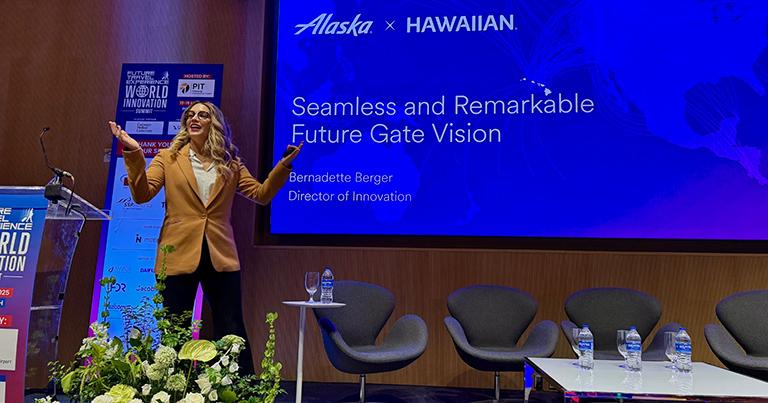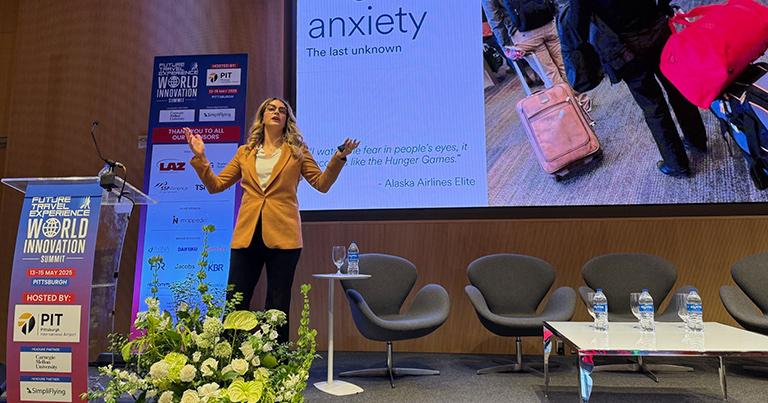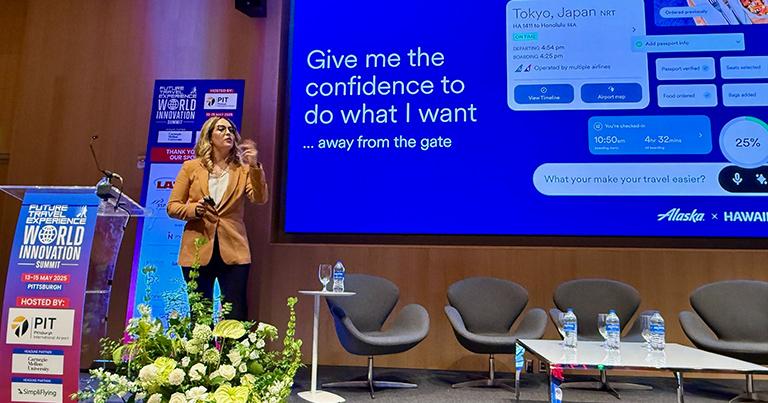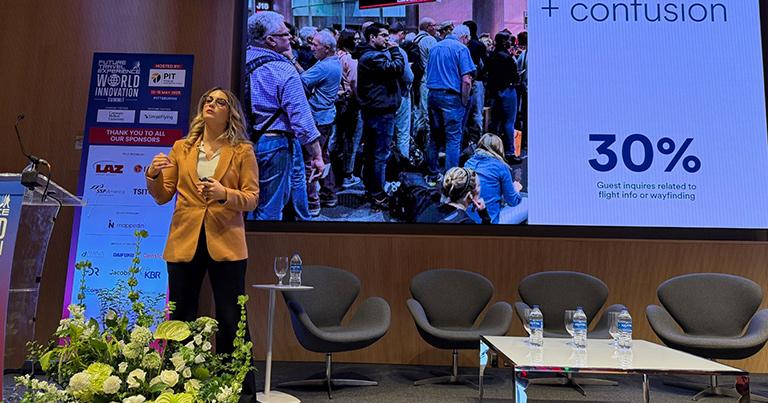
Alaska Airlines Director of Innovation Bernadette Berger took centre stage on 15 May 2025 at the FTE World Innovation Summit in Pittsburgh, unveiling a transformative new vision for airport gate experiences. Presented under the title ‘Seamless and Remarkable: Future Gate Vision,’ Berger shared how Alaska Airlines and Hawaiian Airlines plan to revolutionise pre-flight operations with automation, AI, and human-centred design.
“Looking at the gate with our two eyes, making sure it exists, and then we wait, and we wait in lines,” Berger told the packed audience. “It’s rushed, it’s boring, it’s chaotic, it’s mind-melting, and it’s not a great experience.”
The exciting talk built on Alaska’s other innovative concepts showcased this year, such as the ‘Lobby of the Future’ it revealed at SXSW.
Challenging the status quo of the gate experience
From crowded gate areas to overloaded agents, Alaska Airlines began its redesign by identifying the most common passenger and employee frustrations. Berger emphasised how often travellers remain unsure of even the most basic details of their journey.
“A third of all guest enquiries to our gate agents are ‘am I at the right gate?’ and ‘how do I get to the right gate?’” Berger said.
She referred to a phenomenon Alaska Airlines now calls the “lurch around the door” – passengers clustering near boarding areas in hopes of securing overhead bin space. This behaviour, Berger explained, stems from a lack of what the airline now terms carry-on confidence. “If you’re flying Alaska, you know where you’re going to sit, you know what movies you’re going to watch, you’re probably going to eat a fruit and cheese plate,” Berger said. “The last unknown is: will I have space in the bin for my bag?”

Empowering agents by eliminating repetition
The challenges don’t end with the guest. Berger noted that Alaska’s gate agents face hundreds of tasks on tight deadlines, leaving little time for meaningful interaction. The innovation team set out to measure how agents spend their time and discovered major inefficiencies.
“We started to measure out all of the time spent at the gate for our agents on manual, repetitive tasks,” Berger said. “Those are all really great opportunities for automation.”
Alaska’s vision reallocates that time. A visual diagram showed blue areas for tasks that could be automated and grey areas representing customer care. The goal: shrink the blue, grow the grey.
Defining seamless and remarkable
The cornerstone of Alaska’s strategy combines two guiding concepts: seamless and remarkable.
“Seamless means it’s easy, it’s predictable, I know what to expect,” Berger said. “And as a guest, I’m given the freedom to spend my time how I want, away from the gate.”
To showcase what that looks like in practice, Berger described Alaska’s newly-launched Portland lobby, which allows passengers to self-tag bags and drop them at automated bag drops in under five minutes. “I’ve timed this myself a few times with kids and all the drama that kids bring,” Berger shared. “It’s so much faster without having to wait in a line.”

Personalised and predictive passenger journeys
Berger painted a picture of an experience that gives travellers peace of mind and control. The Alaska Airlines app will display a personal boarding timeline and push proactive updates through text or app notifications. Guests can also interact with an AI assistant using voice commands to locate lounges, request seat upgrades, or access personalised travel tasks.
“You’re not focused on when boarding begins,” she said. “You’re focused on your personal boarding time.”
On the operational side, Alaska is reengineering its agent tools to include a single, unified app on mobile tablets. These allow agents to roam the gate space while maintaining full visibility of flight progress.
“We’re building a new app for our agents that, in one pane of glass, gives them the single view of what’s happening with that flight,” Berger said. “Highly automated processes, but our agents are still in the loop.”
Innovating on the ramp with ‘burning bags’
Berger also turned attention to Alaska’s baggage operations. Working with Pattern Labs, the airline developed automated dispatch tools to better handle tight transfer windows for connecting bags.
“To transfer bags tail to tail in under 60 minutes at major airports is really hard,” she said. “We had to come up with another category – other than hot bags and cold bags – we started calling them ‘burning bags’.”
With the new dispatch system, transfer runners receive assignments on their devices with optimised routing based on gate changes, traffic, and timing. Dispatchers, meanwhile, use a centralised platform called CTAP to visualise operations and respond to problem spots in real time.

Building true ‘carry-on confidence’
To eliminate uncertainty around carry-on availability, Alaska is testing a new pilot with BagsID in Portland. Using computer vision, the system detects and sizes carry-on bags as they board.
“Right now, we have the ability to predict how many bags we think are going to get in the cabin,” Berger said. “But that doesn’t give us visibility into how many bags actually went into the cabin.”
By understanding actual boarding behaviour and volume, Berger hopes to address the psychological trigger that causes gate area crowding.
A future of freedom and care
Berger concluded her keynote with a call to reimagine how travellers use their time. No longer tied to the boarding zone, guests can enjoy the terminal with confidence they’ll board smoothly.
“You’re having a cappuccino, you get a text that your gate is five minutes away, boarding starts in five minutes, here’s your map,” Berger said. “Start walking now.”
The message was clear. Alaska Airlines is not simply redesigning the gate area. It is redefining what travel can feel like.
“The more confidence our guests feel, the more freedom they have,” Berger said. “And when they feel cared for, that’s when the journey becomes memorable.”
You may also be interested in
12 technology and CX trends that can enhance airline and airport operations in 2025






